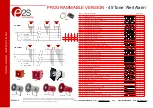
Appendix E: Connecting a Raymarine Heading Sensor
E-1
Co
nn
ect
in
g a
Ra
ym
ar
in
e H
ead
in
g
Sensor
Appendix E: Connecting a Raymarine
Heading Sensor
The performance of MARPA and radar/chart overlay on the
hsb
2
displays is
dependent on the quality of your heading sensor.
Raymarine recommend that, for optimum MARPA and radar/chart overlay
operation, you use Raymarine Rate Gyro Compass or a G-series course
computer, connected via NMEA, as your source of heading data. The G-series
course computer uses rate gyro compensation.
This Appendix provides connection details for a Raymarine 150G or 400G
course computer. For information on the Rate Gyro Compass refer to the
handbook supplied with the compass.
Figure 8-15
on
page 26
shows a typical
Pathfinder system with a Rate Gyro Compass system.
If you have a different heading sensor, or require further assistance, please
contact your authorized Raymarine dealer or Raymarine Technical Support.
G-Series Course Computer
Note:
A 150 or 400 course computer coupled to the optional GyroPlus unit
will provide heading data of equal quality to the 150G or 400G course com-
puter. The method of connecting to your
hsb
2
display is the same.
If you have a Raymarine 150G or 400G course computer we recommend that
you configure your system as follows and illustrated below:
•
Connect the course computer NMEA1 output to the NMEA input on each
of your displays that will be used for MARPA and radar/chart overlay.
•
For each display, in the System Set Up Menu set Bridge NMEA Heading
OFF (see
Bridge NMEA Heading
on
page 7-8
).
Summary of Contents for hsb2 PLUS Series
Page 4: ......
Page 16: ...xiv hsb2 PLUS Series Color LCD Display...
Page 70: ...2 34 hsb2 PLUS Series Color LCD Display Displaying the Radar and Synchronizing Radar Chart...
Page 158: ...6 12 hsb2 PLUS Series Color LCD Display Data Log Mode...
Page 210: ...8 32 hsb2 PLUS Series Color LCD Display Transmitted Data...
Page 232: ...C 6 hsb2 PLUS Series Color LCD Display C MAP Chart Card Features...














































